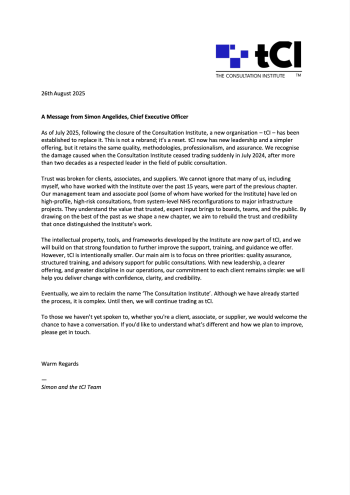tCI Restart
We’re back. tCI has restarted to help you run fair, lawful consultations that stand up to scrutiny. We provide independent assurance, practical advice and guidance, and flexible learning for teams across health, local government, and infrastructure. If you’re planning or delivering a consultation, let’s talk.
From NHS service change to local budgets and infrastructure planning, tCI provides assurance and advice where scrutiny is toughest and decisions matter most
Open Letter
tCI was created to carry forward the best of the Consultation Institute’s legacy. In this open letter, our CEO Simon Angelides shares what we’ve built on, what continues, and how we’re focusing our work for the future.
About tCI
Reintroducing tCI, its mission and focus
We’re back — Trusted assurance for public consultations
We’re back with consultation assurance, training, and guidance. tCI helps organisations run fair, lawful public consultations that follow the Gunning Principles, reflect consultation best practice, provide effective consultation support, and stand up to public and legal scrutiny.

Assurance
Keeping you safe, providing assurance, and ensuring robust consultation processes that hold up to scrutiny

Learning
Practical training with professional certification to deliver fair, lawful, defensible consultations

Advice and Guidance
Independent guidance to plan, test, and deliver fair, lawful, defensible consultations
Why tCI
Building on the Consultation Institute, tCI continues to advance best practice leadership with independent assurance and sector-ready training
Evolves recognised standards:
-
We maintain and update the Institute’s Charter and Gunning-aligned approach into a clear national framework
Independent, court-cited assurance:
-
Readiness audits, QA checkpoints and Statements of Assurance that stand up to legal and public scrutiny; our methods have been cited in courts in England and Wales
Cross-sector support & training:
-
Practical advisory, embedded assurance and certificated programmes that build capability across councils, the NHS and infrastructure
Best practice into action:
-
Plain-English guidance, templates and case learning leaders can use immediately
Our Mission and Services
This short film explains what tCI does and why. You’ll see how we support fair, lawful consultations through proportionate assurance, targeted training, and clear next steps.
Previous Clients









News & Insights
If you have any questions, suggestions or requests please contact us and we will reply as quickly as we can.
